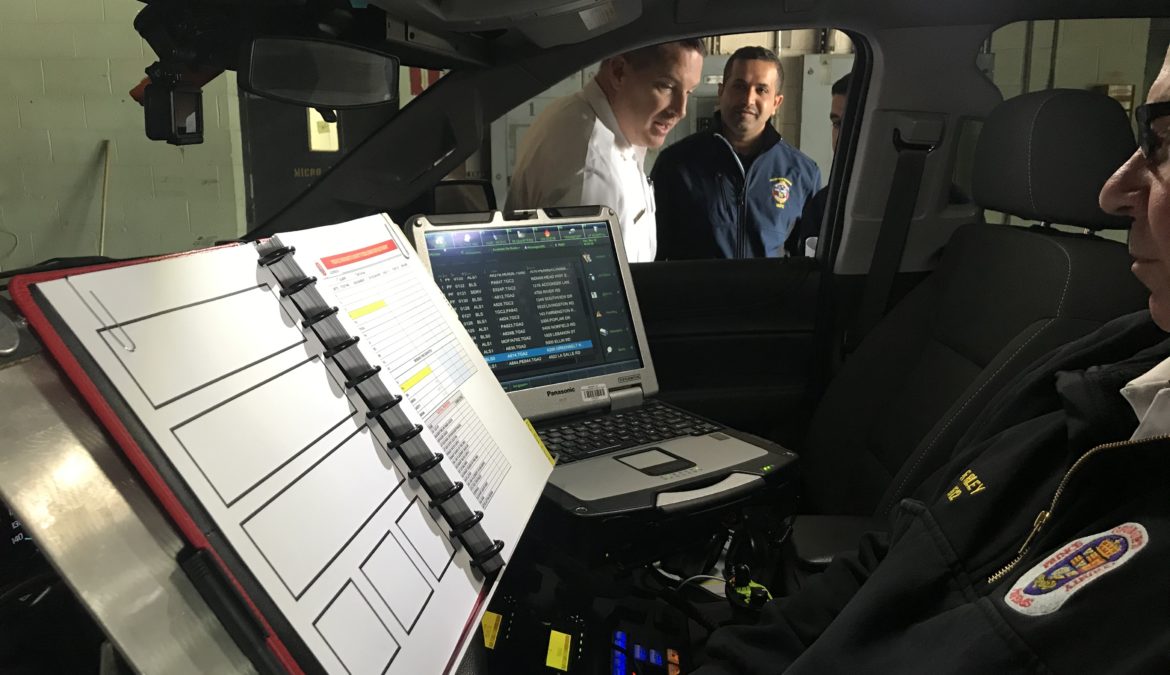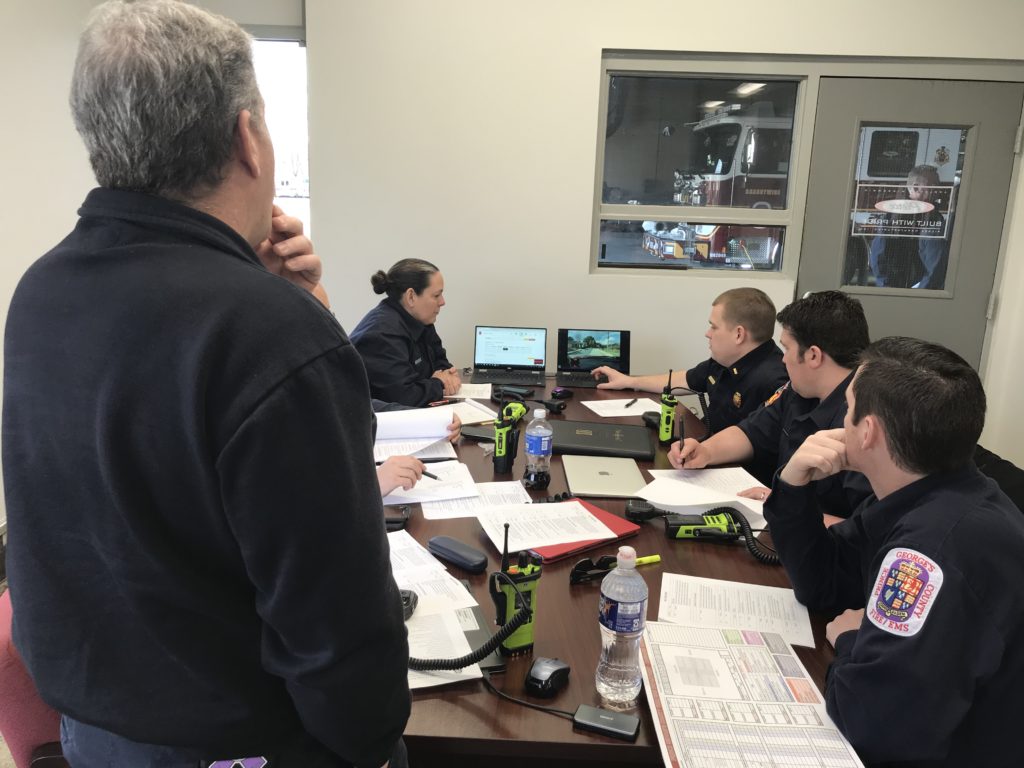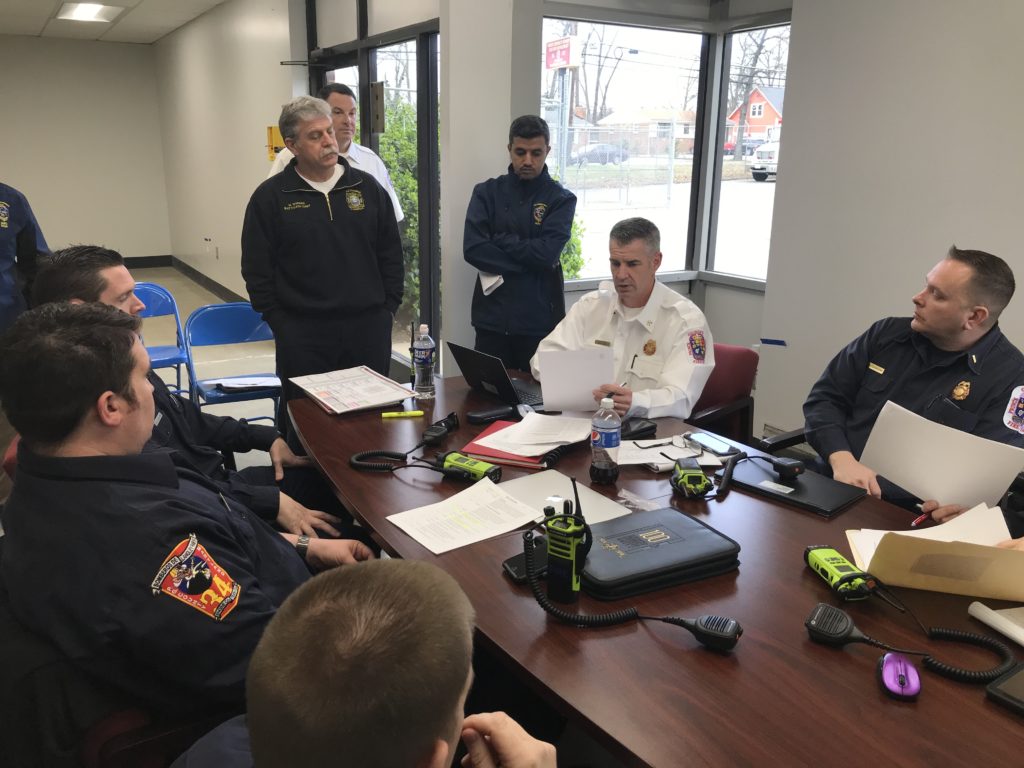With violent attacks increasing in frequency and severity throughout the United States, and victims experiencing time-sensitive, life-threatening injuries, the importance of providing everyday civilians the ability to care for one another is essential for life safety. It has become clear that victims of these catastrophic events experience injuries that need rapid treatment prior to traditional emergency medical services (EMS) arrival, often in austere environments. Through much research and planning, the Maryland-National Capital Region Emergency Response System (MDERS) is providing emergency medical training and supplies to the public, empowering civilians to act as first responders and provide initial care. This program has become known as Public Access Trauma Care (PATC).
In December 2018, the MDERS kicked off the initial planning process for what would become referred to as the PATC Program. The Montgomery County planning team is comprised of representatives from the Office of Emergency Management and Homeland Security (OEMHS), Department of Health and Human Services (MC DHHS), Fire and Rescue (MCFRS), Police Department (MCPD), and Montgomery County Public Schools (MCPS). The team identified several time-sensitive traumatic injuries that that should be addressed by the capability: massive hemorrhage, penetrating wounds, airway compromise, and hypothermia. The group designed a kit that consists of a tourniquet, compression bandage, gauze, chest seals, thermal blankets, medical tape, gloves, scissors, and instructions. The kits are packaged to treat five patients with a single bag. 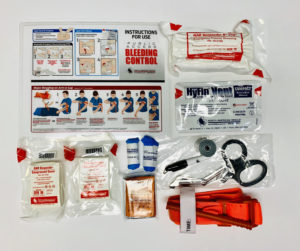
The planning team chose to implement this capability in a phased approach due to the magnitude and potential growth of this project. The phased implementation, which was charted over several years, would allow for flexibility throughout the planning process, as well as provide the opportunity for incremental successes along the way. The planning team developed the following three-phased approach to equip buildings with the PATC supplies:
Phase 1: Montgomery County Public Schools
Phase 2: Government Buildings
Phase 3: Community & Public Areas
The planning team decided that the Montgomery County Public Schools (MCPS) would be the first to receive the PATC kits. Given the current vulnerabilities at schools throughout the country, the planning team decided the installation of the PATC kits in every school in the county would be a major accomplishment and set the tone for jurisdictions throughout the region. To continue implementation with MCPS, the workgroup needed to obtain approval from MCPS Executive Leadership, the final decision-makers of new initiatives impacting their students and faculty. The planning team proposed the following PATC kit allocations for the different levels of schools:
- Elementary Schools – (1) 5-pack kit per school
- Middle Schools – (3) 5-pack kits per school
- High Schools – (20) 5-pack kits per school
The planning team established the following parameters to help determine their PATC kit distribution: populations at risk, the amount of time it would take someone to get to a bleeding control kit, and the number of potential students and faculty utilizing these supplies. MCPS Executive Leadership understood and appreciated the benefit this would provide to their students and faculty, allowing the workgroup to continue their planning efforts and complete Phase 1.
Once the MCPS Executive Leadership gave the authorization to move forward with the project, MDERS worked diligently to begin the Federal Emergency Management Agency’s (FEMA) process to obtain approval for installation in all school buildings, which is a requirement to expend Urban Area Security Initiative grant funds. In Montgomery County, there were a total of 165 schools (102 elementary, 46 middle, and 17 high schools) that were built prior to 1975 that needed to be approved by FEMA before any purchasing and installation occurred. The process to complete the approvals included visits to all 165 schools and documentation of the specific locations where the bleeding control kits would be mounted. MDERS staff divided the county into sections and completed the photo documentation as teams. This process took roughly 4-5 weeks, with MDERS staff coordinated with the school principals and security personnel to ensure a school staff member was able to provide an escort. The grant approval documentation was finalized over several months, and MDERS obtained FEMA approval in November of 2019.
Simultaneously during the FEMA approval process, implementation for Phase 1 continued by providing training to all school nurses and health room technicians. The training was coordinated by MDERS, MC DHHS, and MCPD Special Operations Division (SOD). Several members of MCPD SOD provided in-person training to all school nurses and health room technicians over the course of a few days to ensure they all were comfortable in performing the proper application of the supplies included in the bleeding control kits. Training consisted of a PowerPoint lecture, as well as hands-on skills practice in which trainees were taught how to successfully apply tourniquets and chest seals, identify different wound patterns, and pack deep wounds on trainer devices. At the conclusion of the training, 126 Registered Nurses (RN) and 214 Certified Nursing Assistants (CNA) were trained in PATC, which was a significant first step towards success for MCPS. The positive feedback received after this training guided the workgroup into the next steps of the implementation process.
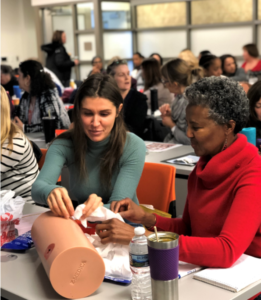
Another important cadre of professionals in the school system is the school security staff. They are assigned to both middle and high schools throughout the county, and their job is to assist school faculty during the day. To enhance this growing PATC capability, MDERS and the planning team realized that the security officers were most likely going to be one of the first on-scene in an emergency.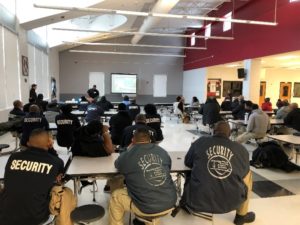 Due to their important responsibilities, all security officers were outfitted with a tourniquet and holster, and emergency trauma dressing to always carry on them. They were also provided with the same training as the school nurses and health technicians. MCPS plans to provide this training to teachers and staff, and has included these skills in their curriculum for high school students in the coming years, building a large cadre of trained responders.
Due to their important responsibilities, all security officers were outfitted with a tourniquet and holster, and emergency trauma dressing to always carry on them. They were also provided with the same training as the school nurses and health technicians. MCPS plans to provide this training to teachers and staff, and has included these skills in their curriculum for high school students in the coming years, building a large cadre of trained responders.
Once training for the nurses, health room technicians, and security officers was complete, PATC workgroup participants began mapping out the extensive operation of installing the bleeding control kits and cabinets throughout the school system. The first rooms to receive bleeding control kits were the health rooms. 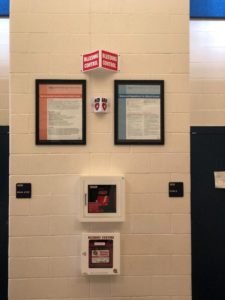 From there, MCPS Systemwide Safety and Emergency Management helped MDERS manage the installation of the remaining bleeding control kits with support from the MCPS Division of Maintenance and Operations. MDERS worked with the Division of Safety and Emergency Management and the Division of Maintenance and Operations to assist with providing the approved FEMA locations for each kit. There were many ad hoc partners that played a defining role in determining the appropriate cabinet and proper placement to ensure MCPS was compliant with the American with Disabilities Act (ADA). Installation for all schools took approximately five weeks. As of December 2020, all MCPS schools have been outfitted with bleeding control kits.
From there, MCPS Systemwide Safety and Emergency Management helped MDERS manage the installation of the remaining bleeding control kits with support from the MCPS Division of Maintenance and Operations. MDERS worked with the Division of Safety and Emergency Management and the Division of Maintenance and Operations to assist with providing the approved FEMA locations for each kit. There were many ad hoc partners that played a defining role in determining the appropriate cabinet and proper placement to ensure MCPS was compliant with the American with Disabilities Act (ADA). Installation for all schools took approximately five weeks. As of December 2020, all MCPS schools have been outfitted with bleeding control kits.
While Phase 1 in one jurisdiction may be complete, the PATC program is just beginning. The program’s ability to immediately render aid during life-threatening emergencies, as well as providing additional responders during mass casualty events, is an important step in building a resilient community. Provision of kits and training to the general public will continue as MDERS strives to bolster emergency response capability and capacity in the Maryland-National Capital Region.

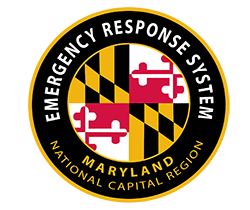
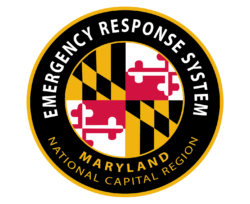




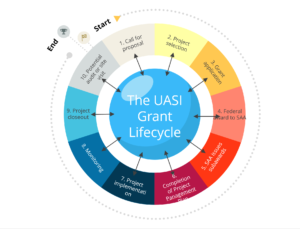
 The Maryland-National Capital Region Emergency Response System is excited to announce that Peter McCullough, JD, has joined the team in a contractor role to assist with numerous evolving projects. Peter joins us from the Center for Health and Homeland Security (CHHS), where he is a Law & Policy Analyst. He is a graduate of the University of Maryland, Francis King Carey School of Law, with a concentration in Cybersecurity and Crisis Management. Most recently, he worked directly with the District of Columbia Homeland Security and Emergency Management Agency (DCHSEMA) as an integral part of the 2021 Presidential Inauguration. He brings both professionalism and a fresh perspective to the field of response. Peter is eager to work with the entire MDERS stakeholder community, sharing his expertise to help enhance many of the current projects.
The Maryland-National Capital Region Emergency Response System is excited to announce that Peter McCullough, JD, has joined the team in a contractor role to assist with numerous evolving projects. Peter joins us from the Center for Health and Homeland Security (CHHS), where he is a Law & Policy Analyst. He is a graduate of the University of Maryland, Francis King Carey School of Law, with a concentration in Cybersecurity and Crisis Management. Most recently, he worked directly with the District of Columbia Homeland Security and Emergency Management Agency (DCHSEMA) as an integral part of the 2021 Presidential Inauguration. He brings both professionalism and a fresh perspective to the field of response. Peter is eager to work with the entire MDERS stakeholder community, sharing his expertise to help enhance many of the current projects.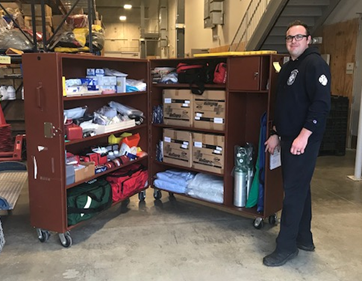
 A fully stocked EMS in a Box Storage cabinet.
A fully stocked EMS in a Box Storage cabinet.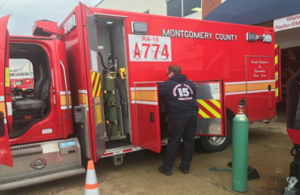
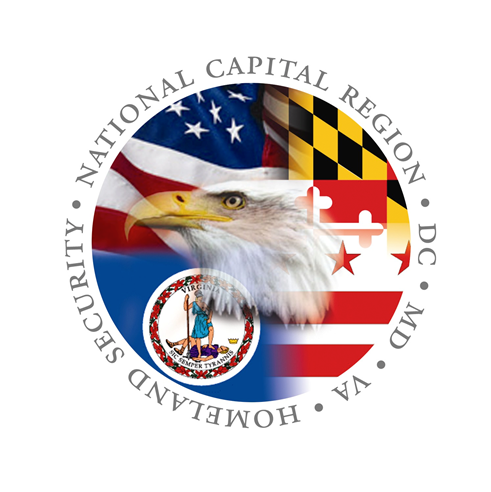


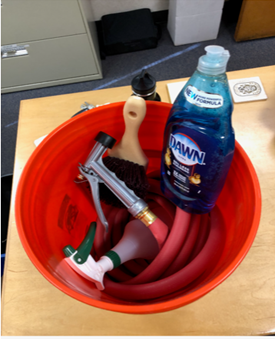
 Firefighter decontamination supplies are stored in a five-gallon bucket. Each bucket contains (1) pump panel hose adapter, (1) 25’ section of hose, (1) nozzle, (1) scrub brush, and (1) container of Dawn dish soap. All engine companies within the Montgomery County Fire and Rescue Service and Prince George’s County Fire/EMS Department carry these supplies, in addition to 1000 gallons of water. Firefighters from the engine company assemble and connect the equipment. The engine officer coordinates the assembly of personnel, sequence of flow, and completion of the action. This firefighter decontamination project provides safe, efficient, and effective decontamination services at the scene.
Firefighter decontamination supplies are stored in a five-gallon bucket. Each bucket contains (1) pump panel hose adapter, (1) 25’ section of hose, (1) nozzle, (1) scrub brush, and (1) container of Dawn dish soap. All engine companies within the Montgomery County Fire and Rescue Service and Prince George’s County Fire/EMS Department carry these supplies, in addition to 1000 gallons of water. Firefighters from the engine company assemble and connect the equipment. The engine officer coordinates the assembly of personnel, sequence of flow, and completion of the action. This firefighter decontamination project provides safe, efficient, and effective decontamination services at the scene.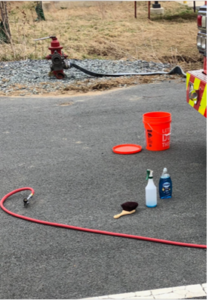 The decontamination process is initiated by the incident commander. A “Decontamination Team” is then assigned, and personnel are expected to follow the department policy and procedures of gathering equipment, deploying the hose, and connecting the nozzle. After the Decontamination Leader tells command the site location, personnel (in their firefighter gear) walk the decontamination line. Teams apply a soapy mixture with a brush and scrub exposed personnel head to toe. Each member exits the line after a complete water rinse down. Once complete, the crews reassemble to return to their fire station for additional clean-up activities. The unit and incident commander document the activities in the fire record management system.
The decontamination process is initiated by the incident commander. A “Decontamination Team” is then assigned, and personnel are expected to follow the department policy and procedures of gathering equipment, deploying the hose, and connecting the nozzle. After the Decontamination Leader tells command the site location, personnel (in their firefighter gear) walk the decontamination line. Teams apply a soapy mixture with a brush and scrub exposed personnel head to toe. Each member exits the line after a complete water rinse down. Once complete, the crews reassemble to return to their fire station for additional clean-up activities. The unit and incident commander document the activities in the fire record management system.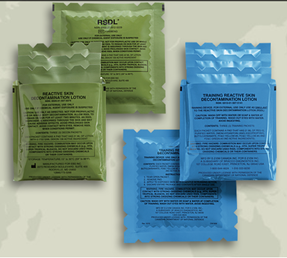 In spring 2021, police officers in the Special Operations Division of MCPD and PGPD received a set of individual decontamination wipes. These products provide point of exposure tools to clear off any substances as early as possible. Combined with the brush-off supplies, these items start the decontamination process. The police officers training plan includes the use of these products in combination with the fire/EMS supplies. Once exposed, the officer uses the wipes and quickly moves to fire/EMS resources for a head-to-toe soap and water scrub down. Additional decontamination measures are completed with medical assessment and treatment.
In spring 2021, police officers in the Special Operations Division of MCPD and PGPD received a set of individual decontamination wipes. These products provide point of exposure tools to clear off any substances as early as possible. Combined with the brush-off supplies, these items start the decontamination process. The police officers training plan includes the use of these products in combination with the fire/EMS supplies. Once exposed, the officer uses the wipes and quickly moves to fire/EMS resources for a head-to-toe soap and water scrub down. Additional decontamination measures are completed with medical assessment and treatment.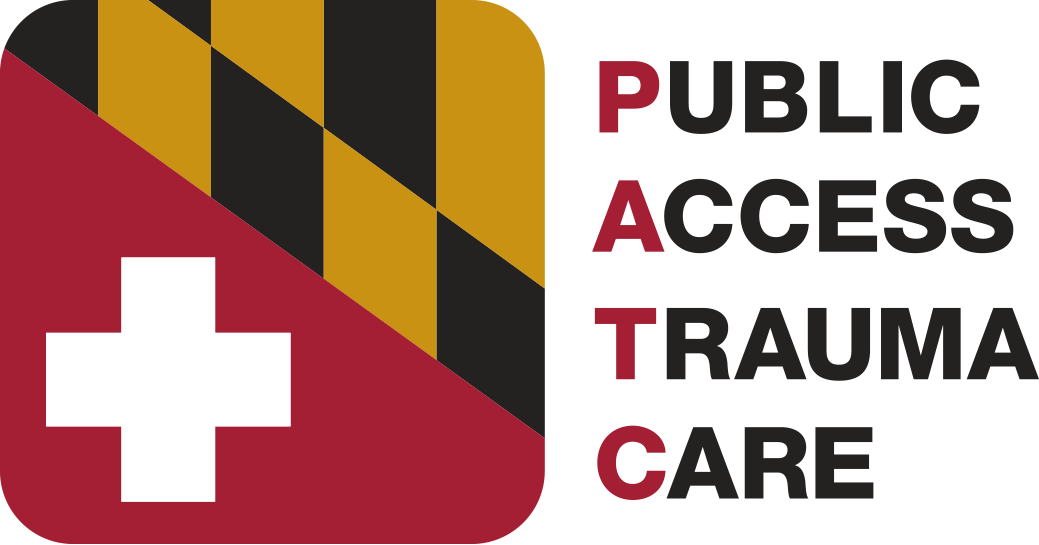


 Due to their important responsibilities, all security officers were outfitted with a tourniquet and holster, and emergency trauma dressing to always carry on them. They were also provided with the same training as the school nurses and health technicians. MCPS plans to provide this training to teachers and staff, and has included these skills in their curriculum for high school students in the coming years, building a large cadre of trained responders.
Due to their important responsibilities, all security officers were outfitted with a tourniquet and holster, and emergency trauma dressing to always carry on them. They were also provided with the same training as the school nurses and health technicians. MCPS plans to provide this training to teachers and staff, and has included these skills in their curriculum for high school students in the coming years, building a large cadre of trained responders. From there, MCPS Systemwide Safety and Emergency Management helped MDERS manage the installation of the remaining bleeding control kits with support from the MCPS Division of Maintenance and Operations. MDERS worked with the Division of Safety and Emergency Management and the Division of Maintenance and Operations to assist with providing the approved FEMA locations for each kit. There were many ad hoc partners that played a defining role in determining the appropriate cabinet and proper placement to ensure MCPS was compliant with the American with Disabilities Act (ADA). Installation for all schools took approximately five weeks. As of December 2020, all MCPS schools have been outfitted with bleeding control kits.
From there, MCPS Systemwide Safety and Emergency Management helped MDERS manage the installation of the remaining bleeding control kits with support from the MCPS Division of Maintenance and Operations. MDERS worked with the Division of Safety and Emergency Management and the Division of Maintenance and Operations to assist with providing the approved FEMA locations for each kit. There were many ad hoc partners that played a defining role in determining the appropriate cabinet and proper placement to ensure MCPS was compliant with the American with Disabilities Act (ADA). Installation for all schools took approximately five weeks. As of December 2020, all MCPS schools have been outfitted with bleeding control kits.
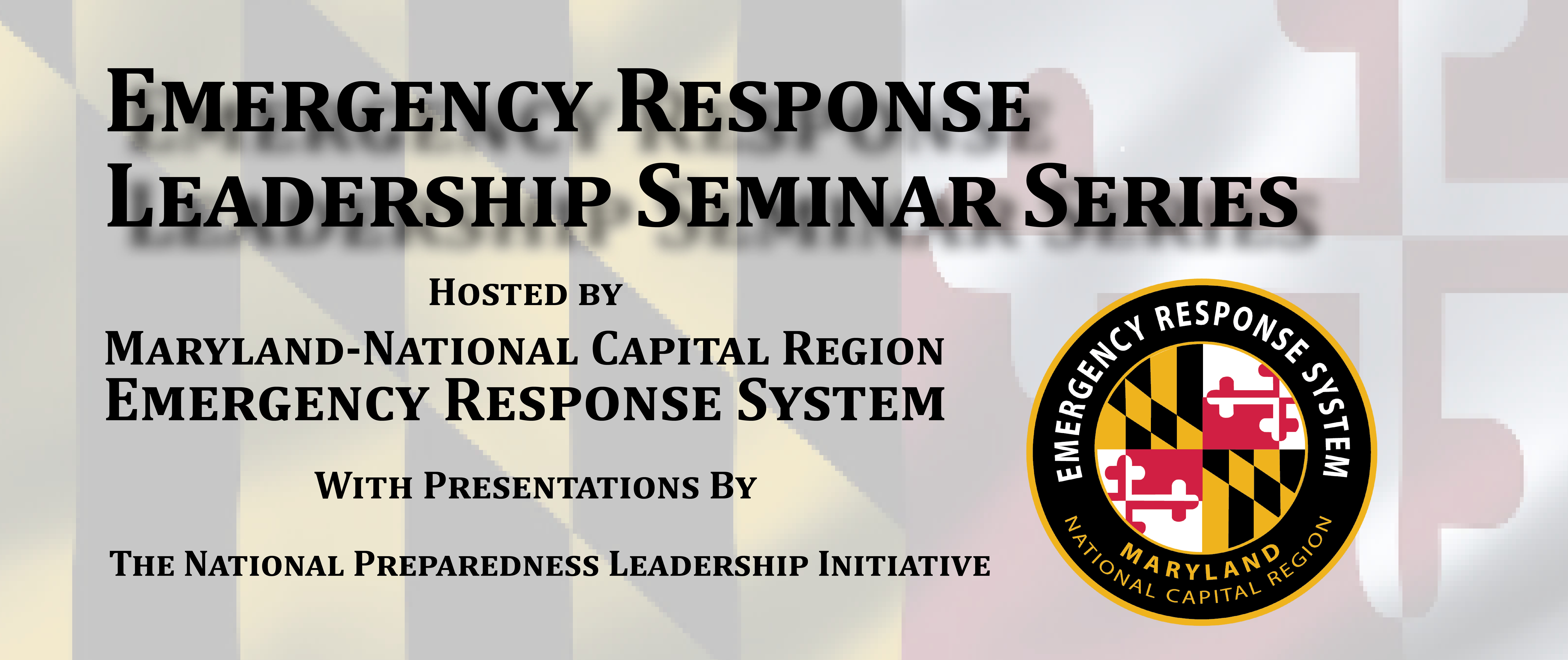
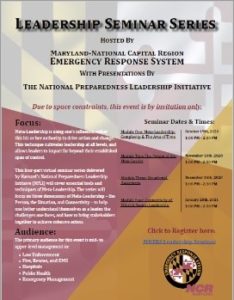 years. Some of the most popular include the Annual Maryland-National Capital Region Emergency Response Symposium and the 2019 Fall Leadership Seminar. Participants in these programs consistently requested more opportunities for leadership education and development. These requests drove MDERS, in partnership with Harvard University’s National Preparedness Leadership Initiative (NPLI), to recently host a four-part Virtual Emergency Response Leadership Seminar Series for leaders in the National Capital Region (NCR). The series included essential tools and techniques of Meta-Leadership.
years. Some of the most popular include the Annual Maryland-National Capital Region Emergency Response Symposium and the 2019 Fall Leadership Seminar. Participants in these programs consistently requested more opportunities for leadership education and development. These requests drove MDERS, in partnership with Harvard University’s National Preparedness Leadership Initiative (NPLI), to recently host a four-part Virtual Emergency Response Leadership Seminar Series for leaders in the National Capital Region (NCR). The series included essential tools and techniques of Meta-Leadership.